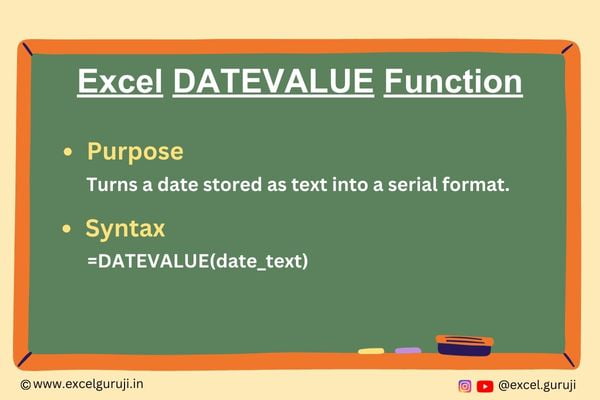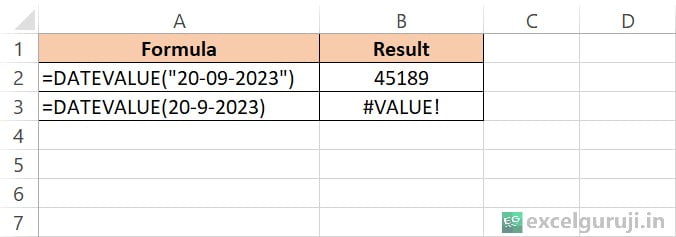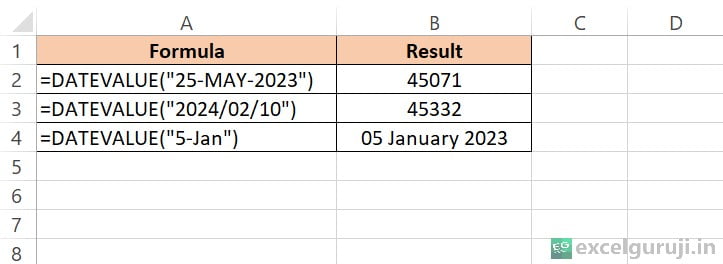Contents
Excel DATEVALUE Function

When to Use the Excel DATEVALUE Function in Excel
The DATEVALUE function in Excel is used when you have date information stored as text and need to convert it into a numerical date format.
This is particularly useful in scenarios where you receive data from external sources or when dates are entered in a non-standard format that Excel doesn’t recognize as dates. By using DATEVALUE, you can perform various date-related calculations, sorting, and filtering tasks with ease.
What Excel DATEVALUE Function Returns
The DATEVALUE function in Excel returns a serial number that represents a specific date. This serial number is the numerical equivalent of the date in Excel’s date system, where January 1, 1900, is represented as 1 and each subsequent day is incremented by one.
Syntax of Excel DATEVALUE Function
The syntax of the Excel DATEVALUE function is as follows:
=DATEVALUE(date_text)
Input Arguments
Here are the input arguments for the Excel DATEVALUE function:
● date_text: This is the text representation of the date that you want to convert into a numerical date. It can be a direct text entry enclosed in quotation marks, a reference to a cell containing the date text, or a formula that evaluates to date text.
Extra Notes
● The Excel DATEVALUE function will generate a #VALUE! error if the date_text does not have a valid date in text format.
● When the year part is missing in the date_text, DATEVALUE uses your computer’s current year from its internal clock.
● Any time details within the date_text are ignored
● The DATEVALUE function will return a #VALUE! error if the date_text argument contains an valid date, as illustrated in the example below.
Examples of the Excel DATEVALUE Function
Let’s walk through a few examples of using the Excel DATEVALUE function in Excel:
Example 1: Basic Conversion
Use quotation marks to explicitly denote date text when working with the Excel DATEVALUE function to avoid errors and ensure accurate date conversions.

Certainly! Let’s explain the two examples
(1) =DATEVALUE(“20-09-2023”)
- In this example, we have a correctly formatted date text enclosed in quotation marks: “20-09-2023”. The DATEVALUE function recognizes this as a valid date in the format “dd-mm-yyyy” (day-month-year), which is common in many parts of the world. It converts this text into its numerical date representation, which, in this case, is 45189, representing September 20, 2023, in Excel’s date system.
(2) =DATEVALUE(20-9-2023)
- In this example, the date text is not enclosed in quotation marks. Excel interprets the expression 20-9-2023 as a mathematical operation because there are no quotation marks to indicate that it is text. Since subtraction is not possible with a date, Excel returns a #VALUE! error.
Example 2: Some Other Example
Here are some more examples demonstrate how the DATEVALUE function can interpret date text in various formats, including both short and long month names, and generate the corresponding numerical date representation in Excel.

Let’s explain
(1) =DATEVALUE(“25-MAY-2023”)
- In this example, we have a date text “25-MAY-2023” enclosed in quotation marks. The DATEVALUE function recognizes this as a valid date in the format “dd-MMM-yyyy” (day-month-year), where “MAY” represents the month of May. It converts this text into its numerical date representation, which, in this case, is 45071, representing May 25, 2023, in Excel’s date system.
(2) =DATEVALUE(“2024/02/10”)
- In this example, we have a date text “2024/02/10” enclosed in quotation marks. The DATEVALUE function recognizes this as a valid date in the format “yyyy/mm/dd” (year/month/day). It converts this text into its numerical date representation, which is 45332, representing February 10, 2024, in Excel’s date system.
(3) =DATEVALUE(“5-Jan”)
- In this example, we have a date text “5-Jan” enclosed in quotation marks. The DATEVALUE function recognizes this as a valid date but doesn’t have the year information. Excel, by default, uses the current year from the computer’s built-in clock to complete the date. So, if we use this formula in 2023, it will convert “5-Jan” to “05 January 2023”.
Conclusion
In conclusion, the Excel DATEVALUE function is an essential tool for converting date text into numerical dates, allowing you to work with dates more effectively in your spreadsheets.
Whether you’re dealing with imported data or non-standard date formats, DATEVALUE can help you bring order to your date-related tasks.
Remember that Excel offers a wide range of date functions to perform various operations with dates, and mastering them can greatly enhance your Excel proficiency. So, start using DATEVALUE today and elevate your ability to handle dates in Excel like a pro.
Frequently Asked Questions (FAQs)
Q1: Can the DATEVALUE function convert dates and times together?
A1: No, the DATEVALUE function is designed specifically for converting date text into numerical dates. If you need to convert date and time text into numerical date-time values, you may need to use other functions like DATEVALUE in combination with TIMEVALUE.
Q2: Is the DATEVALUE function sensitive to date formats?
A2: Yes, the DATEVALUE function is sensitive to the date format used in the date_text argument. It will interpret the date text based on the format specified, so make sure the date_text matches the format you intend to use.
Q3: What happens if the date_text argument is not a valid date?
A3: If the date_text argument is not a valid date, the DATEVALUE function will return a #VALUE! error. Ensure that the date text is correctly formatted to avoid errors.
Q4: Can I use cell references for the date_text argument in the DATEVALUE function?
A4: Yes, you can use cell references that contain date text as the date_text argument in the DATEVALUE function. This allows you to work with dynamic date data in your Excel worksheets.
Other Related Excel Functions
Join me on Instagram and YouTube for your daily dose of valuable tips and tricks! Catch insightful videos that will enhance your knowledge and skills. Don’t miss out – follow me now!